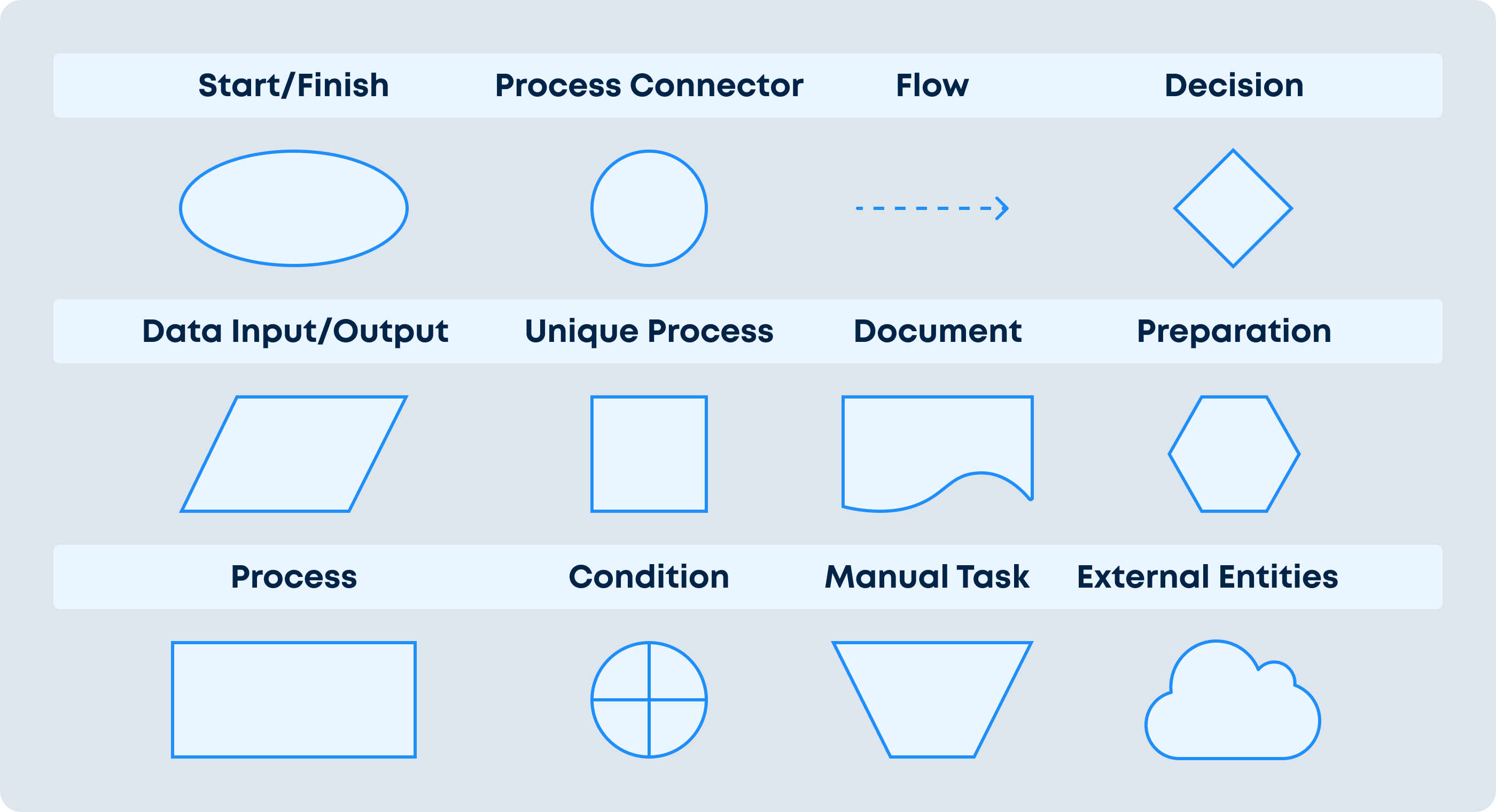Process map symbols are a constant element of business process mapping that provide a standardized visual language for representing different elements. They help communicate complex information in a clear way, allowing you to easily understand and analyze the structure and flow of any process.
In this article, we’ll explore the most common process mapping symbols and see how they can enable effective communication across various stakeholders within your organization.
Common Business Process Map Symbols

Let’s start with the most basic process map shapes you’ll encounter during a business process management initiative. And if you need more information on the practical implementation, you can find it in our detailed guide on how to create a process map.
Many of these symbols derive from Business Process Model and Notation, a standard mapping system developed and managed by the Object Management Group.
Oval
The oval shape is used to indicate the start and end points of a business process or activity. Also called “the terminator,” it looks like a rectangle but with rounded rather than sharp corners.
Circle
Circles with reference numbers are often used as connectors to indicate that a process continues on another page or elsewhere in the document. These symbols help to maintain the flow of the process map when it becomes too complex to fit on a single page or screen.
An upside-down pentagon can also serve this purpose; think of this process mapping symbol as a bridge to the next section.
Arrow
Arrows are used to connect the various symbols in a process map, showing the direction a given process flows. The arrowheads indicate the sequence in which activities occur, helping to illustrate the order of operations.
When you have two intersecting connections, arrow placement designates the main and secondary processes. The arrow for the primary process should appear on top of the secondary arrow.
In a process map, an arrow typically connects the starting oval symbol to the first step, and another arrow connects the end symbol to the final oval to show that the process is over. A complicated process may have several stop and start points before it finally ends.
Diamond
Diamonds depict decision points within a process. A decision symbol typically contains a question or statement that leads to different possible outcomes. The outgoing arrows from the diamond represent the various choices or paths the user can take.
In general, the “yes” decision should follow the flow of the process while the “no” arrow should branch off to the side. Some systems may show a gate symbol to indicate a decision point instead of a diamond.
Parallelogram
A parallelogram represents data input or output: either information entered into the workflow or information generated as a result of the process. Labeling the parallelogram clarifies the type of data involved.
Square
A square symbol shows a specialized or unique process within the main process flow. When you see a square on your map, it means that a different set of rules or conditions applies to this particular step.
Rectangle with a Wavy Bottom
For these process map symbols, picture a piece of paper torn off at the bottom. This symbol represents a document or report. It is used to show a point when a document is created, modified or reviewed. Some systems stack several of these symbols to show that a step involves multiple documents.
Hexagon
A hexagon represents manual process input, such as data entered by a human operator. This symbol allows you to identify the need for employee intervention in a partially automated workflow at a glance. Some process maps instead use a hand symbol to show the point where a human steps into the system.
Rectangle
Rectangles represent all of the various tasks, activities and operations within a process. Each rectangular box contains a brief description of the action. The arrows connecting these rectangles indicate the sequence of events from beginning to end.
A rectangle inscribed with a horizontal line inside each short end indicates a subprocess. You can use this symbol to indicate tasks within a larger operational workflow.
Circle With Lines
A circle with lines inside represents a set of rules or conditions within a process. It indicates that the system itself makes a decision or action based on predefined rules or criteria. Whenever this symbol appears in your process map, it shows that a task can benefit from automation, if it hasn’t already been implemented.
Trapezoid
An upside-down trapezoid symbol signifies a predefined or standardized manual task within the main process. These process map symbols can be useful when breaking down complex processes into more manageable components.
Cloud
A cloud symbol represents external entities that interact with the main process but exist outside the control of your organization. Examples include customers, suppliers, vendors and other external stakeholders.
How technicians at RWE Renewables reduce daily form completion time by 45%


Advanced Process Map Symbols and Notation

In addition to the basic process mapping symbols, complicated workflows or distinctive process map types may benefit from the use of these advanced process map symbols. They facilitate more detailed and specific representations to accurately capture complex organizational interactions.
Pentagon
A pentagon symbol signifies the end of a process path when multiple alternatives have been considered and the final outcome or resolution is reached. You can use it as an alternative to the oval when you need more complex process map symbols.
Octagon
Use the stop-sign shape when you need to show the end of a subprocess within a larger process map. Like the pentagon, it adds clarity to a more complex process document.
Trapezoid
The trapezoid symbol defines a looping process or subprocess. It indicates that the action will take place over and over again until someone manually ends the loop.
Comment Bubble
Annotations or notes can be added in comment bubbles to provide additional details or explanations about a specific part of the process. These process map symbols look like a speech balloon in a comic book. Annotations can help users understand complex or critical components of the process.
Cylinder
A cylinder is used to represent data storage. For example, your workflow may include a database or repository where the system stores or retrieves information during the process.
Circle with an X
Using a circle inscribed with an X shows a point where the user can take more than one of multiple paths, also known as an “and” logic point. When you use a plus sign inside a circle, it shows that the system or user must decide to take just one of multiple paths.
Triangle
An upside-down triangle shows a point in the process where several steps converge. For example, you may need to illustrate multiple workstreams that eventually come together
Rectangle with a Pointed Side
A rectangle with rounded corners is used to denote a point in the process where information is presented to users. This could include displaying data, presenting reports, showing user interfaces, or any other form of information presentation.
Rectangle with Curved Sides
This symbol signifies a point in a process where data is exchanged, transferred, or shared between different components or steps. It represents the flow of information between elements within the process. This rectangle can include the passing of information between different departments, systems, or individuals involved in the workflow.
Hourglass Symbol
The hourglass shows a point in the process that requires data collation. It indicates that you need to gather multiple resources into one document or package. The inverted hourglass, which looks like a diamond bisected by a horizontal line, shows that the system must sort or filter data based on an established order.
Rectangle with a Wavy Side
This rectangle with one rounded side looks like the letter D, and serves to indicate a waiting period within a process where no active work is being performed. It indicates that there is a temporary delay in the progression of the workflow, often due to factors such as time constraints, resource availability, or the need to wait for external inputs.
Best Practices for Process Map Symbols
Use symbols and notations judiciously. Process mapping symbols should always provide clarity for the user. A cluttered or overly complex process map can be difficult to understand.
When you need to map a complicated workflow, consider numbering the process map shapes. This step can help keep everything organized and make it easier for the user to navigate the document.
By the same token, ensure consistency in symbol usage and notation throughout the map. If you use a particular symbol for a decision point in one part of the process, continue to use the same symbol for decision points elsewhere. Ideally, you should define a
In addition to the basic process mapping symbols, complicated or distinctive workflows may benefit from the use of these advanced process map symbols. They facilitate more detailed and specific representations to accurately capture complex organizational interactions.
Want to Start Automating Your Workflows and Processes?
Let us show you how you can do it quickly in Fluix